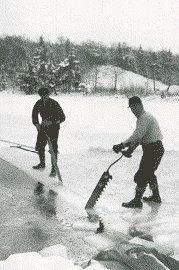
|
Back to Settlements Introduction History Farming Church School Hall Transportation |
The More Things Change...
Over the development of the Kynoch settlement there have been two significant changes in how life is lived. The first change was in the area of transportation. The second has to do with the introduction of electricity in the community. When the pioneers first came to the settlement of Kynoch, their main mode of transportation was oxen and wagon. The oxen were very soon replaced by the more efficient horse. Families usually kept a team of work horses, and at least one horse to drive, though some kept more. Today people leave at a moments notice to get groceries in Thessalon, about 35 kilometers away. When horses were used, it took two days to go to town, buy supplies, and return home. In time horses were replaced by automobiles. Introduced into the community in about 1920, cars gave inhabitants the ability to travel greater distances in less time. With the improvements in roads and quality of automobiles over the years, greater mobility has been achieved. In The HouseElectricity was a big catalyst to change in Kynoch in 1954. It brought comforts to the community which the most of the country had enjoyed for years. Prior to 1954, plumbing was primitive at best. Most houses were without running water, though some had a small pump. In most cases, water had to be hauled from wells. The outhouse was the precurser to the indoor bathroom. Maintainence was minimal, the most necessary (and important) requirement being to put lye in the toilet weekly to keep the smell and flies down. 
Doing the laundry was a time consuming task. Earlier it was done with a tub and washboard. Clothes were either wrung by hand or with a wringer, and hung to dry on a clothesline. For some residents, the washboard was replaced by gas washers. Washing clothes became easier, though water still had to be carried to the machine.  Without electricity there were obviously no refrigerators. An ice house was used to keep food cold. Ice was hauled from nearby lakes. Packed in the icehouse and covered with sawdust, ice would keep for most of the summer. Some people, as an alternative to the icehouse, would dig a well and fill it with ice over the winter. This was done by putting some water in the well everyday, and letting it freeze during the winter. Enough space was left in the well to hang what needed to be frozen. Lighting was provided by coal oil lamps and gas lanterns. Cooking was done on a wood cookstove, which made the house hot in the summer. Most families had a summer kitchen where they moved the stove in the summer. Quite often Kynoch residents would make maple syrup. Wooden spiles were used, and sap collected in an even split block that was hollowed out. In later years buckets replaced the wooden blocks. The sap was boiled down in kettles over an open fire. The syrup was made for the use of the family. Today syrup is still made, through some valley residents now sell what they produce. Spiles, in some cases, have been replaced by pipelines which make collecting the sap much easier. Evaporators are now also used, though they haven't entirely replaced the kettles over the open fire. Today, the process varies little from the way it was done originally. Return to Top |
Home | Natural Environment | History | Industry | Personalities/Stories | Credits/Team